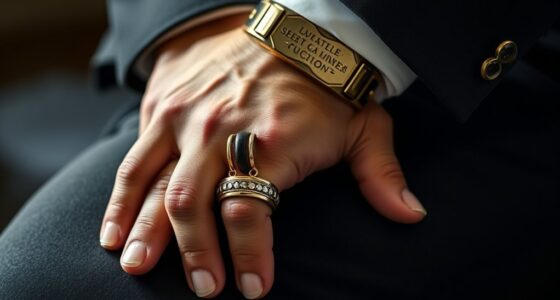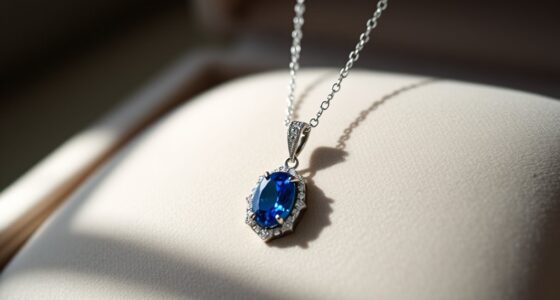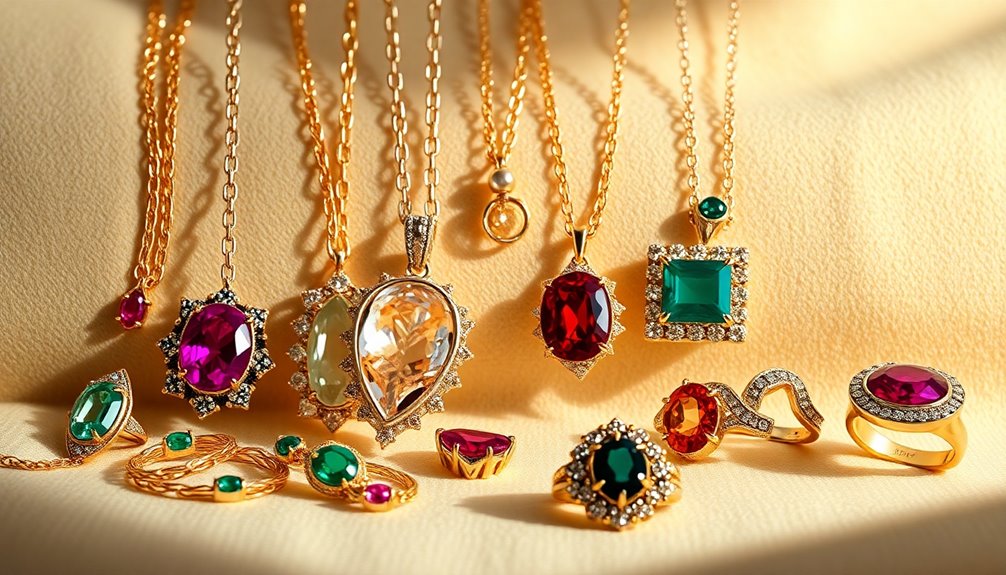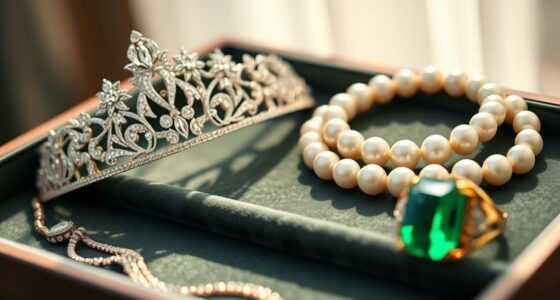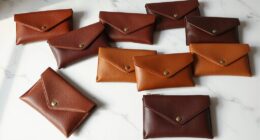To see if your gold jewelry is real, start by checking for proper karat stamps like 14K or 18K, but remember marks can be fake. Use a magnet—real gold isn’t magnetic—then try a scratch test on a ceramic tile; genuine gold leaves a gold streak, while fake leaves a black or green mark. You can also gently clean it to spot discoloration, or consult a professional for more precise tests. If you want more details, keep going for helpful tips.
Key Takeaways
- Check for genuine karat marks like 14K or 18K, but verify authenticity as marks can be fake.
- Perform a scratch test on a testing stone; real gold leaves a gold-colored streak.
- Examine the jewelry for discoloration, peeling, or tarnish, which indicate fake plating.
- Use a magnet to test; real gold is non-magnetic, so attraction suggests a fake.
- For certainty, consult a professional jeweler for acid or advanced testing methods.

Wondering if your gold jewelry is genuine? It can be tricky to tell just by looking at it, but there are simple tests you can do to find out. One of the most reliable methods is gold karat testing, which helps determine the purity of your jewelry. Many gold items are marked with a karat stamp, like 14K or 18K, but these marks can sometimes be misleading or even faked. To be sure, you might consider a professional test, or you can try some at-home methods. A common starting point is to perform a visual inspection, checking for any discoloration or peeling that might indicate gold plating over a base metal. Keep in mind, however, that visual cues alone aren’t definitive.
Next, you can try a simple scratch test on a less visible area of your jewelry. Lightly scratching it against a ceramic tile or testing stone can reveal whether it’s real gold. Genuine gold will leave a gold-colored streak, whereas fake or plated jewelry might leave a black or greenish mark. While this test is quick, it does carry some risk of scratching or damaging your piece, so use it carefully. If you’re unsure, gold jewelry cleaning can also help reveal authenticity. Real gold doesn’t tarnish or change color over time, so cleaning it with a gentle solution can restore its shine and make it easier to see any signs of fake plating or discoloration.
Another effective test involves a magnet. Gold isn’t magnetic, so if your jewelry strongly attracts to a magnet, it likely isn’t pure gold. Keep in mind, though, that some non-gold metals are also non-magnetic, so this isn’t foolproof but still a helpful clue. For more precise results, you might consider an acid test or consulting a jeweler who can perform professional gold karat testing.
Ultimately, careful observation combined with simple tests can go a long way in helping you determine if your gold jewelry is real. Regular cleaning not only keeps your jewelry looking its best but can also reveal inconsistencies that suggest it’s not genuine. If you’re still uncertain, taking your jewelry to a professional is always a safe bet. They can perform definitive tests that will confirm its authenticity. With these straightforward steps, you’ll be better equipped to identify real gold and avoid falling for fake or plated pieces.
Frequently Asked Questions
Can Fake Gold Pass All Authenticity Tests?
Fake gold can’t pass all authenticity tests. Gold plating often wears off, revealing a base metal underneath, and fake gold markings may look convincing but aren’t genuine. You might think it’s real after a quick check, but sophisticated fakes can mimic the appearance and even pass superficial tests. To truly verify, you need to conduct more thorough tests, as fake gold is designed to deceive even seasoned buyers.
How Does Gold Purity Affect Its Value?
Imagine a shimmering piece of gold, its purity shining through. The higher the karat weight, the more pure gold it contains, making it more valuable. Gold alloy mixes base metals, reducing purity and value. When you hold jewelry, a higher karat weight feels richer and more substantial, reflecting its true worth. So, your gold’s purity, measured by karat, directly influences its beauty and monetary value.
Are There Specific Brands Known for Fake Gold?
You should know that some brands have a reputation for producing counterfeit markers or fake gold items, making it tricky to spot genuine jewelry. While most reputable brands maintain high standards, lesser-known or cheap brands might be more likely to sell fake gold. Always check the brand reputation and look for counterfeit markers, such as inconsistent hallmarks or poor craftsmanship, to verify you’re buying authentic gold jewelry.
How Should I Store Real Gold Jewelry?
When it comes to gold storage, you want to keep your jewelry in a safe, dry place to prevent tarnishing and damage. Use a soft pouch or jewelry box with separate compartments to avoid scratches. Proper jewelry care includes cleaning your gold regularly and avoiding exposure to harsh chemicals. This way, your gold jewelry stays beautiful and retains its value over time.
Is It Safe to Test Gold at Home?
While DIY testing can seem tempting, you should consider safety precautions first. At-home tests might involve acids or sharp tools, which can be risky if you’re not careful. You could accidentally damage your jewelry or harm yourself. Instead, use safe methods like visual inspection or a magnet test. If you’re unsure, it’s better to consult a professional jeweler to avoid unnecessary damage or injury.
Conclusion
Now that you know these simple tests, you can confidently spot real gold without a magic wand. Remember, a quick scratch test or magnet check can save you from buying a phony. Think of it as your own personal Sherlock Holmes moment—minus the deerstalker hat. With these tricks, you’ll be the gold guru of your circle, even if you’re just channeling your inner Leonardo da Vinci. Happy hunting, and may your jewelry always be the real deal!



